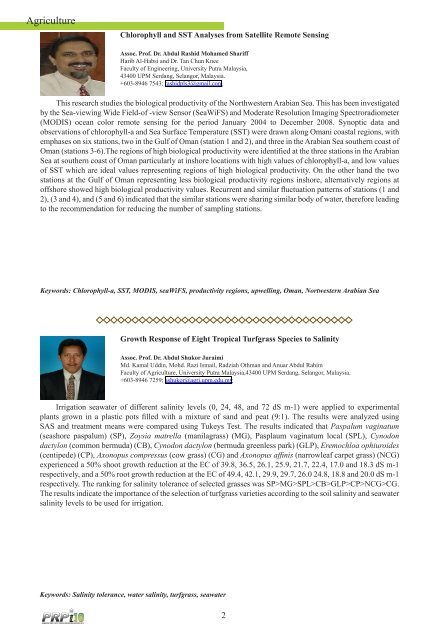BUKU ABSTRAK - Universiti Putra Malaysia
BUKU ABSTRAK - Universiti Putra Malaysia
BUKU ABSTRAK - Universiti Putra Malaysia
You also want an ePaper? Increase the reach of your titles
YUMPU automatically turns print PDFs into web optimized ePapers that Google loves.
Agriculture<br />
Chlorophyll and SST Analyses from Satellite Remote Sensing<br />
Assoc. Prof. Dr. Abdul Rashid Mohamed Shariff<br />
Harib Al-Habsi and Dr. Tan Chun Knee<br />
Faculty of Engineering, University <strong>Putra</strong> <strong>Malaysia</strong>,<br />
43400 UPM Serdang, Selangor, <strong>Malaysia</strong>.<br />
+603-8946 7543; rashidpls3@gmail.com<br />
This research studies the biological productivity of the Northwestern Arabian Sea. This has been investigated<br />
by the Sea-viewing Wide Field-of -view Sensor (SeaWiFS) and Moderate Resolution Imaging Spectroradiometer<br />
(MODIS) ocean color remote sensing for the period January 2004 to December 2008. Synoptic data and<br />
observations of chlorophyll-a and Sea Surface Temperature (SST) were drawn along Omani coastal regions, with<br />
emphases on six stations, two in the Gulf of Oman (station 1 and 2), and three in the Arabian Sea southern coast of<br />
Oman (stations 3-6).The regions of high biological productivity were identified at the three stations in the Arabian<br />
Sea at southern coast of Oman particularly at inshore locations with high values of chlorophyll-a, and low values<br />
of SST which are ideal values representing regions of high biological productivity. On the other hand the two<br />
stations at the Gulf of Oman representing less biological productivity regions inshore, alternatively regions at<br />
offshore showed high biological productivity values. Recurrent and similar fluctuation patterns of stations (1 and<br />
2), (3 and 4), and (5 and 6) indicated that the similar stations were sharing similar body of water, therefore leading<br />
to the recommendation for reducing the number of sampling stations.<br />
Keywords: Chlorophyll-a, SST, MODIS, seaWiFS, productivity regions, upwelling, Oman, Nortwestern Arabian Sea<br />
Growth Response of Eight Tropical Turfgrass Species to Salinity<br />
Assoc. Prof. Dr. Abdul Shukor Juraimi<br />
Md. Kamal Uddin, Mohd. Razi Ismail, Radziah Othman and Anuar Abdul Rahim<br />
Faculty of Agriculture, University <strong>Putra</strong> <strong>Malaysia</strong>,43400 UPM Serdang, Selangor, <strong>Malaysia</strong>.<br />
+603-8946 7259; ashukor@agri.upm.edu.my<br />
Irrigation seawater of different salinity levels (0, 24, 48, and 72 dS m-1) were applied to experimental<br />
plants grown in a plastic pots filled with a mixture of sand and peat (9:1). The results were analyzed using<br />
SAS and treatment means were compared using Tukeys Test. The results indicated that Paspalum vaginatum<br />
(seashore paspalum) (SP), Zoysia matrella (manilagrass) (MG), Pasplaum vaginatum local (SPL), Cynodon<br />
dactylon (common bermuda) (CB), Cynodon dactylon (bermuda greenless park) (GLP), Eremochloa ophiuroides<br />
(centipede) (CP), Axonopus compressus (cow grass) (CG) and Axonopus affinis (narrowleaf carpet grass) (NCG)<br />
experienced a 50% shoot growth reduction at the EC of 39.8, 36.5, 26.1, 25.9, 21.7, 22.4, 17.0 and 18.3 dS m-1<br />
respectively, and a 50% root growth reduction at the EC of 49.4, 42.1, 29.9, 29.7, 26.0 24.8, 18.8 and 20.0 dS m-1<br />
respectively. The ranking for salinity tolerance of selected grasses was SP>MG>SPL>CB>GLP>CP>NCG>CG.<br />
The results indicate the importance of the selection of turfgrass varieties according to the soil salinity and seawater<br />
salinity levels to be used for irrigation.<br />
Keywords: Salinity tolerance, water salinity, turfgrass, seawater<br />
2



